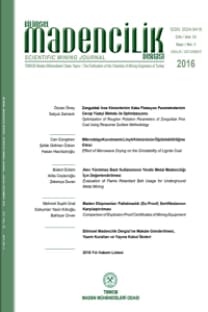ATIK BASKILI DEVRE KARTLARININ EKONOMİK POTANSİYELİ VE ÇEVRESEL KARAKTERİZASYONU
Atık elektrikli ve elektronik eşyalar (AEEE veya e-atık) zararlı organik ve inorganik maddeler içermektedir. Diğer taraftan AEEE, yüksek temel (özellikle Cu) ve değerli metal (Au, Ag ve Pd) içerikleri nedeniyle önemli bir ikincil kaynaktır. Bu atıkların uygun şekilde yönetilmemesi hem ekonomik kayıplara yol açmakta hem de evsel atıklarla birlikte depolanması durumunda çevre kirliliğine neden olabilmektedir. AEEE’deki ağır ve değerli metallerin önemli bölümü atık baskılı devre kartlarında (ABDK) bulunmaktadır. Bu çalışmada, ABDK’nın temel ve değerli metal içeriğine bağlı olarak ekonomik potansiyeli ortaya konulmuştur. Ayrıca, atık bilgisayarlardan toplanan ABDK’ya (%18,5 Cu, 86 g/t Au, 694 g/t Ag ve 97 g/t Pd) çevresel karakterizasyon testleri uygulanmıştır. TCLP testi (Toxic Characteristic Leaching Procedure) sonuçlarına göre ABDK, yüksek kurşun (Pb) salınımı nedeniyle “zararlı atık” sınıfındadır. SPLP (Synthetic Precipitation Leaching Procedure) ve EN 12457-2 (European Standard Leaching Test) testlerinde de bazı metallerin (Ba/Al/Pb/Cu) yüksek salınım gösterdiği belirlenmiştir. Elde edilen sonuçlar, AEEE yönetiminde atık depolama yerine geri dönüşüm/kazanım süreçleri ile metallerin kazanılmasının en uygun çözüm olduğunu göstermektedir
Anahtar Kelimeler:
E-atık, geri dönüşüm/kazanım, liç, karakterizasyon
ECONOMIC POTENTIAL AND ENVIRONMENTAL CHARACTERISATION OF WASTE OF PRINTED CIRCUIT BOARDS
Waste electrical and electronic equipments (WEEE or e-waste) contain hazardous organic and inorganic substances. On the other hand, WEEE is an important secondary resource due to its base (mainly Cu) and precious metals (Au, Ag and Pd) content. Improper management of this waste stream leads to economic losses as well as environmental pollution if disposed in landfills with municipal wastes. The major part of heavy and precious metals in WEEE is present in waste of printed circuit boards (WPCB). This study highlights the economic potential of WPCB with regards to its base and precious metal content. In addition, environmental characterisation procedures were tested using WPCB (18.5% Cu, 86 g/t Au, 694 g/t Ag and 97 g/t Pd) collected from obsolete computers. TCLP test (Toxicity Characteristic Leaching Procedure) results showed that WPCB should be classified as “hazardous waste” due to high lead (Pb) concentration in the leachate. In the SPLP (Synthetic Precipitation Leaching Procedure) and EN 12457-2 (European Standard Leaching Test) tests, some metals (Ba/Al/Pb/Cu) also determined to be highly solubilised. These results indicated that recovery of metals from WEEE through recycling/recovery processes is the most suitable route for proper management compared with disposing these wastes in landfills
Keywords:
E-waste, recycling/recovering, leaching, characterization,
- ISSN: 2564-7024
- Yayın Aralığı: Yılda 4 Sayı
- Yayıncı: TMMOB Maden Mühendisleri Odası
Sayıdaki Diğer Makaleler
Cengiz Karagüzel, Oktay Şahbaz, Kenan Oğul, Ali Uçar
BİTLİS VE VAN İLLERİNDE POMZA MADENCİLİĞİNE GENEL BİR BAKIŞ
ATIK BASKILI DEVRE KARTLARININ EKONOMİK POTANSİYELİ VE ÇEVRESEL KARAKTERİZASYONU
Ersin Yener Yazıcı, Hacı Deveci
KÖMÜR YIKAMA TESİS ATIKLARININ SUSUZLANDIRILMASINDA ESKİ VE YENİ TEKNOLOJİLER
